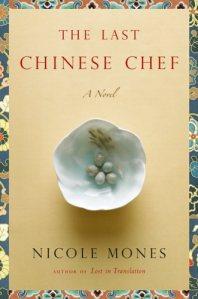***½
The Last Chinese Chef
 Author: Nicole Mones
Author: Nicole Mones
First Edition: 2007
Original language: English
Summary:
It has been a year since Maggie’s husband passed away, but she has been unable to rebuild her life after his sudden death. She has sold their house and moved into a small house boat, and her work as an American food writer is the only thing that keeps her going. Predictably, she is devastated when a paternity claim arises against her husband’s estate from a young woman in China, where her husband used to travel for work. Serendipitously, an assignment on a Chinese-American Chef comes up at her magazine and Maggie decides to take it on as she will already be traveling to Beijing to settle the paternity suit.
In Beijing, Maggie is thrown into Chinese culture and especially its food. Led by Sam, the shy chef, Maggie explores the amazing world of food through Chinese eyes, as well as discovers herself and learns about her relationship with her husband.
Quotes:
“We strive to fool the diner for a moment. It adds a layer of intellectual play to the meal.”
“The gourmet was as important as the chef.”
“Xian means the sweet, natural flavor- like butter, fresh fish, luscious clear chicken broth. Then we have xiang, the fragrant flavor – think frying onions, roasted meat. Nong is the concentrated flavor, the deep, complex taste you get from meat stews or dark sauces or fermented things. Then there is the rich flavor, the flavor of fat. This is called yur er bu ni, which means to taste of fat without being oily. We love this one. Fat is very important to us. Fat is not something undesirable to be removed and thrown away, not in China…”
“That’s just flavor. We have texture. There are ideas of texture, too- three main ones. Cui is dry and crispy, nun is when you take something fibrous like shark’s fin and make it smooth and yielding, and ruan is perfect softness – velveted chicken, a soft-boiled egg.”
“It was more honest to take home an animal and slaughter it than to buy its meat in a square, shrink-wrapped package, more honest to keep a fish alive and swimming until the moment you wished to devour it.”
“They were Sam’s generation, and he thought of them as one thinks of far-off cousins, rarely seen but always spoken of with fondness.”
“The high point of a meal was never the food itself, he taught us, but always the act of sharing it.”
Opinion:
This book made me want to visit China just so I could EAT. I love the descriptions of the foods, dishes, meals, and preparation. I was transported to the kitchens and dining rooms that Maggie visits on her trip. I now have a list of about ten dishes that I want to try. I have always been curious about Chinese food culture, and I think this was a good introduction to some of its principles. I really liked the descriptions of flavors and textures (quoted above). I also loved the description of China mainly through its food and food-related customs. That’s exactly how I would describe all of my trips!
I loved the part about the bamboo flowering. Apparently, bamboo rarely flowers, sometimes not in 100 years. However, once one bamboo blooms, all the others begin to bloom as well. That would be a sight to see!
As far as the plot, I thought it was pretty entertaining, however, the food was the real star of this novel. I did love the uncles and father, as well as the cousins. Mones’ description of the Chinese family and their connection to food was great to read about. Great book for foodies!
Back to Book Reviews
